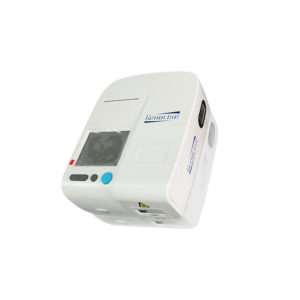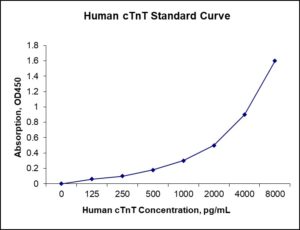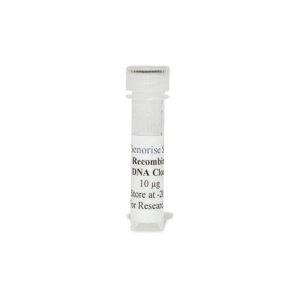Nori Human cTnT ELISA Kit
$461.00 – $832.00
This ELISA kit is for quantification of cTnT in human. This is a quick ELISA assay that reduces time to 50% compared to the conventional method, and the entire assay only takes 3 hours. This assay employs the quantitative sandwich enzyme immunoassay technique and uses biotin-streptavidin chemistry to improve the performance of the assays. An antibody specific for cTnT has been pre-coated onto a microplate. Standards and samples are pipetted into the wells and any cTnT present is bound by the immobilized antibody. After washing away any unbound substances, a detection antibody specific for cTnT is added to the wells. Following wash to remove any unbound antibody reagent, a detection reagent is added. After intensive wash a substrate solution is added to the wells and color develops in proportion to the amount of cTnT bound in the initial step. The color development is stopped, and the intensity of the color is measured.
Alternative names for cTnT: Cardiac troponin T
This product is for laboratory research use only, not for diagnostic and therapeutic purposes or any other purposes.
- Description
- How Elisa Works
- Product Citations
- Reviews (0)
Description
Nori Human cTnT ELISA Kit Summary
Alternative names for cTnT: Cardiac troponin T
| Assay Type | Solid Phase Sandwich ELISA |
| Format | 96-well Microplate or 96-Well Strip Microplate |
| Method of Detection | Colorimetric |
| Number of Targets Detected | 1 |
| Target Antigen Accession Number | P45379 |
| Assay Length | 3 hours |
| Quantitative/Semiquantitative | Quantitative |
| Sample Type | Plasma, Serum, Cell Culture, Urine, Cell/Tissue Lysates, Synovial Fluid, BAL, |
| Recommended Sample Dilution (Plasma/Serum) | No dilution for sample <ULOQ; sufficient dilution for samples >ULOQ |
| Sensitivity | 25 pg/mL |
| Detection Range | 125-8000 pg/mL |
| Specificity | Human cTnT |
| Cross-Reactivity | < 0.5% cross-reactivity observed with available related molecules, < 50% cross-species reactivity observed with species tested. |
| Interference | No significant interference observed with available related molecules |
| Storage/Stability | 4 ºC for up to 6 months |
| Usage | For Laboratory Research Use Only. Not for diagnostic or therapeutic use. |
| Additional Notes | The kit allows for use in multiple experiments. |
Standard Curve
Kit Components
1. Pre-coated 96-well Microplate
2. Biotinylated Detection Antibody
3. Streptavidin-HRP Conjugate
4. Lyophilized Standards
5. TMB One-Step Substrate
6. Stop Solution
7. 20 x PBS
8. Assay Buffer
Other Materials Required but not Provided:
1. Microplate Reader capable of measuring absorption at 450 nm
2. Log-log graph paper or computer and software for ELISA data analysis
3. Precision pipettes (1-1000 µl)
4. Multi-channel pipettes (300 µl)
5. Distilled or deionized water
Protocol Outline
1. Prepare all reagents, samples and standards as instructed in the datasheet.
2. Add 100 µl of Standard or samples to each well and incubate 1 h at RT.
3. Add 100 µl of Working Detection Antibody to each well and incubate 1 h at RT.
4. Add 100 µl of Working Streptavidin-HRP to each well and incubate 20 min at RT.
5. Add 100 µl of Substrate to each well and incubate 5-30 min at RT.
6. Add 50 µl of Stop Solution to each well and read at 450 nm immediately.
Background:
Cardiac Troponin T (TnT), is a protein which in humans is encoded by the TNNT2 gene.[1] Cardiac TnT is the tropomyosin-binding subunit of the troponin complex, which is located on the thin filament of striated muscles and regulates muscle contraction in response to alterations in intracellular calcium ion concentration. Cardiac TnT is a 35.9 kDa protein composed of 298 amino acids.[2] Cardiac TnT is the largest of the three troponin subunits (cTnT, troponin I (TnI), troponin C (TnC)) on the actin thin filament of cardiac muscle. The structure of TnT is asymmetric; the globular C-terminal domain interacts with tropomyosin (Tm), TnI and TnC, and the N-terminal tether which strongly binds Tm. The N-terminal region of TnT is alternatively spliced, accounting for multiple isoforms observed in cardiac muscle.[3] As part of the Troponin complex, the function of cTnT is to regulate muscle contraction. The N-terminal region of TnT that strongly binds actin most likely moves with Tm and actin during strong myosin crossbridge binding and force generation. This region is likely involved in the transduction of cooperativity down the thin filament. The C-terminal region of TnT constitutes part of the globular troponin complex domain and participates in employing the calcium sensitivity of strong myosin crossbridge binding to the thin filament. Mutations in this gene have been associated with familial hypertrophic cardiomyopathy as well as with restrictive[4] and dilated cardiomyopathy. Transcripts for this gene undergo alternative splicing that results in many tissue-specific isoforms, however, the full-length nature of some of these variants has not yet been determined. Mutations of this gene may be associated with mild or absent hypertrophy and predominant restrictive disease, with a high risk of sudden cardiac death.[4] Advancement to dilated cardiomyopathy may be more rapid in patients with TNNT2 mutations than in those with myosin heavy chain mutations.[5]
References
- Townsend PJ, et al. (1994). Genomics 21 (2): 311–6.
- Zong, N. C. et al. (2013). Circulation Research 113 (9): 1043–53.
- Anderson PA, et al (1991). Circulation Research 69 (5).
- Revera M, et al. (2007). Cardiovascular Journal of Africa 18 (3): 146–53.
- Fujino N, et al. (2002). The American Journal of Cardiology 89 (1): 29–33.





























Reviews
There are no reviews yet.